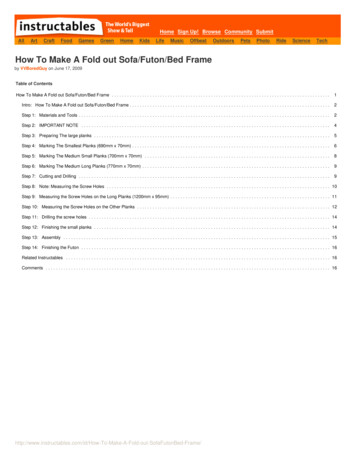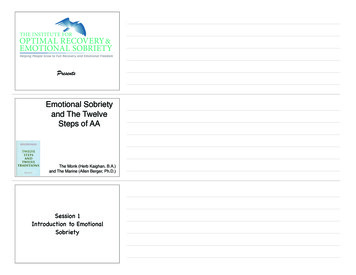
Transcription
Home Sign Up! Browse Community fbeatOutdoorsPetsPhotoRideScienceTechHow To Make A Fold out Sofa/Futon/Bed Frameby VVBoredGuy on June 17, 2009Table of ContentsHow To Make A Fold out Sofa/Futon/Bed Frame . . . . . . . . . . . . . . . . . . . . . . . . . . . . . . . . . . . . . . . . . . . . . . . . . . . . . . . . . . . . . . . . . . . . . . . . . . . . . . . . . . . . . .1Intro: How To Make A Fold out Sofa/Futon/Bed Frame . . . . . . . . . . . . . . . . . . . . . . . . . . . . . . . . . . . . . . . . . . . . . . . . . . . . . . . . . . . . . . . . . . . . . . . . . . . . . . .2Step 1: Materials and Tools . . . . . . . . . . . . . . . . . . . . . . . . . . . . . . . . . . . . . . . . . . . . . . . . . . . . . . . . . . . . . . . . . . . . . . . . . . . . . . . . . . . . . . . . . . . . . . . . . . .2Step 2: IMPORTANT NOTE . . . . . . . . . . . . . . . . . . . . . . . . . . . . . . . . . . . . . . . . . . . . . . . . . . . . . . . . . . . . . . . . . . . . . . . . . . . . . . . . . . . . . . . . . . . . . . . . . .4Step 3: Preparing The large planks . . . . . . . . . . . . . . . . . . . . . . . . . . . . . . . . . . . . . . . . . . . . . . . . . . . . . . . . . . . . . . . . . . . . . . . . . . . . . . . . . . . . . . . . . . . . .5Step 4: Marking The Smallest Planks (690mm x 70mm) . . . . . . . . . . . . . . . . . . . . . . . . . . . . . . . . . . . . . . . . . . . . . . . . . . . . . . . . . . . . . . . . . . . . . . . . . . . . . .6Step 5: Marking The Medium Small Planks (700mm x 70mm) . . . . . . . . . . . . . . . . . . . . . . . . . . . . . . . . . . . . . . . . . . . . . . . . . . . . . . . . . . . . . . . . . . . . . . . . .8Step 6: Marking The Medium Long Planks (770mm x 70mm) . . . . . . . . . . . . . . . . . . . . . . . . . . . . . . . . . . . . . . . . . . . . . . . . . . . . . . . . . . . . . . . . . . . . . . . . . .9Step 7: Cutting and Drilling . . . . . . . . . . . . . . . . . . . . . . . . . . . . . . . . . . . . . . . . . . . . . . . . . . . . . . . . . . . . . . . . . . . . . . . . . . . . . . . . . . . . . . . . . . . . . . . . . . .9Step 8: Note: Measuring the Screw Holes . . . . . . . . . . . . . . . . . . . . . . . . . . . . . . . . . . . . . . . . . . . . . . . . . . . . . . . . . . . . . . . . . . . . . . . . . . . . . . . . . . . . . . . . 10Step 9: Measuring the Screw Holes on the Long Planks (1200mm x 95mm) . . . . . . . . . . . . . . . . . . . . . . . . . . . . . . . . . . . . . . . . . . . . . . . . . . . . . . . . . . . . . . . 11Step 10: Measuring the Screw Holes on the Other Planks . . . . . . . . . . . . . . . . . . . . . . . . . . . . . . . . . . . . . . . . . . . . . . . . . . . . . . . . . . . . . . . . . . . . . . . . . . . . 12Step 11: Drilling the screw holes . . . . . . . . . . . . . . . . . . . . . . . . . . . . . . . . . . . . . . . . . . . . . . . . . . . . . . . . . . . . . . . . . . . . . . . . . . . . . . . . . . . . . . . . . . . . . . . 14Step 12: Finishing the small planks . . . . . . . . . . . . . . . . . . . . . . . . . . . . . . . . . . . . . . . . . . . . . . . . . . . . . . . . . . . . . . . . . . . . . . . . . . . . . . . . . . . . . . . . . . . . . 14Step 13: Assembly . . . . . . . . . . . . . . . . . . . . . . . . . . . . . . . . . . . . . . . . . . . . . . . . . . . . . . . . . . . . . . . . . . . . . . . . . . . . . . . . . . . . . . . . . . . . . . . . . . . . . . . . . 15Step 14: Finishing the Futon . . . . . . . . . . . . . . . . . . . . . . . . . . . . . . . . . . . . . . . . . . . . . . . . . . . . . . . . . . . . . . . . . . . . . . . . . . . . . . . . . . . . . . . . . . . . . . . . . . 16Related Instructables . . . . . . . . . . . . . . . . . . . . . . . . . . . . . . . . . . . . . . . . . . . . . . . . . . . . . . . . . . . . . . . . . . . . . . . . . . . . . . . . . . . . . . . . . . . . . . . . . . . . . . . . 16Comments . . . . . . . . . . . . . . . . . . . . . . . . . . . . . . . . . . . . . . . . . . . . . . . . . . . . . . . . . . . . . . . . . . . . . . . . . . . . . . . . . . . . . . . . . . . . . . . . . . . . . . . . . . . . . . . . ld-out-SofaFutonBed-Frame/
Intro: How To Make A Fold out Sofa/Futon/Bed FrameI enjoy relaxing on a sofa and in my bed, and so it may come as no surprise that I would wish to combine the two. After searching Ikea and several other shops, I foundthe average price for a "tri-fold" futon was in the region of 120GBP ( 150). I found this pretty steep for what is basically some planks of pine and a mattress.So I decided to make my own.Let me make this clear before I begin: This Instructable is only how to build the frame. I have not yet worked out how I will make the mattress or if I will attempt to buyone, but in the instructables spirit if anyone has any suggestions, suggest away.This futon folds in three sections to give a comfortably wide (4ft) and long (6ft-ish) bed that could sleep two (if proximity is not an issue!). When it is folded up it formsa sofa that is close to the ground and has an open angle (about 100 degrees) which I find very comfortable to sit on.I am not a carpenter, crafstman or a great DIY-er, I didn't even take wood tech in school, so this instructable is very accessable. So get up off your computer and turn thatempty space in your bedroom or living room into a versatile piece of furniture! If I can do it, so can you!Step 1: Materials and ToolsThis is the list of materials and tools I used during the project. The wood I used was pine as it is cheap, relatively strong yet a little springy to make the futon a bit morecomfortable. The type of wood you use is up to you but in my opinion, pine works best. My local hardware store cut the planks for me at no extra cost, but depending onwhere you go they may charge 10% extra: this is worth it.Wood:12 x 1200mm x 95mm planks (20mm thickness: I think this is standard)2 x 770mm x 70 mm planks (20mm thickness)2 x 700mm x 70 mm planks (20mm thickness)2 x 690mm x 70 mm planks (20mm thickness)Also some kind of stain, oil or wax to protect it and make it look good.Nuts, Bolts and Screws:46 x 40mm screws (4mm head)4 x 6mm bolts (6mm is the diameter: length needs to be no less than 45mm, 50mm is ideal)4 x 6mm wingnuts (or regular nuts, but wingnuts are easier to use in assembly and disassembly)Tools:PencilRuler (graduated in millimetres)Set Square (or similar)ProtractorElectric Screwdriver/Drill2.5mm drill bit6.5mm drill bitManual ScrewdriverSawMedium Grade SandpaperRasp or planer (a rasp is a bit like reusable, very coarse sandpaper, but a planer would work just as well)OptionalScrap piece of wood to test drill bits and screwsCatThe total cost of the wood came to around 33GBP ( 40) and the screws, bolts and nuts totalled about 2GBP ( 2.50). I alreday had the teak oil so the total cost for thisproject (assuming you have all the tools) is around 35GBP ( 45), but again this depends on where you -Fold-out-SofaFutonBed-Frame/
Image Notes1. 2.5 mm drill bit2. Manual Screwdriver (always have this to hand even if you have an electricone)3. 36 40mm screws (4mm head)4. 4 6mm bolts (6mm is the diameter: length needs to be no less than 45mm,50mm is ideal)5. 4 6mm wingnuts6. electric drill (screwdriver)7. set square (or similar)8. pencil9. ruler (with millimetres not inches)10. Rasp (or Planer)11. medium grade glasspaper12. 6.5mm drill bitImage Notes1. 12 1200mm x 95mm planks of pine2. Manual Screwdriver (always have this to hand even if you have an electricone)3. 36 40mm screws (4mm head)4. 2.5 mm drill bit5. 6.5 mm drill bit6. electric drill (screwdriver)7. 4 6mm bolts (6mm is the diameter: length needs to be no less than 45mm,50mm is ideal)8. 4 6mm wingnuts9. 2 690mm x 70mm planks of pine10. 12 700mm x 70mm planks of pine11. 2 770mm x 70mm planks of pine12. pencil13. ruler14. set square (or similar)15. Rasp (or Planer)16. medium grade glasspaper17. (optional) scrap piece of pine to test drill bits and screws18. old-out-SofaFutonBed-Frame/
Image Notes1. ProtractorImage Notes1. Optional CatStep 2: IMPORTANT NOTEWhen doing any measurements throughout this instructable, remember to MEASURE TWICE, CUT ONCE. This is very important as mistakes are easy to make andrushing things is not a good idea.Other notes to do with safety:- Always clamp wood that you are drilling or cutting- Work in a clean, dry and well ventilated area- Make sure you know how to use the saw and electric drill correctly and safely- DO NOT work when you are tired or have drunk alcohol: you will make mistakes and you could injure e-A-Fold-out-SofaFutonBed-Frame/
Step 3: Preparing The large planksFor this step you will need the rasp or planer, and the glasspaper. You will be working on the 12000mm x 95mm planks.1. Use the rasp to shamfer the edges slightly.2. Glasspaper the plank to smooth the edges and surfaces, paying particular attention to the ends.(The glasspapering is easier if you wrap the glasspaper around a small block of wood. I cut a piece of scrap I had lying around.)Do this for all 12 -A-Fold-out-SofaFutonBed-Frame/
Image Notes1. sandpaper wrapped over block of woodStep 4: Marking The Smallest Planks (690mm x 70mm)***Look at step 7 before doing the measuring to get an idea of what they should look like***The smallest planks (690mm x 70mm) need to have a small section cut out of one end, the other end tapered slightly and one drill hole.Small Section (requires some accurate measuring)1. Measure 85mm down from one end and mark it.2. At this mark draw a perpendicular line across the wood using the set square.3. Measure an angle of 7 degrees from one of the edges. Rule a line.4. Measure 37mm along this line (starting from the edge) and mark it.5. From this point measure an angle of 95 degrees towards the end of the plank. Rule a line.6. Shade in the section in the 95 degree angle and the other side of the 7 degree angle. This is the bit to be cut out (main picture).Drill Hole (mark this before the tapered end)1. Measure 30mm down and mark it.2. At this mark draw a perpendicular line across the wood using the set square.3. Halfway in (35mm) mark the drill hole.Tapered End (basically two triangles)1. At the end with the drill hole, measure 20mm down and 20mm across the top. Draw a line.2. This is the triangle to be cut out.3. Repeat on other side.Image Notes1. 85 ld-out-SofaFutonBed-Frame/
Image Notes1. 7 degreesImage Notes1. 35mm inImage Notes1. 95 -A-Fold-out-SofaFutonBed-Frame/
Image Notes1. finished markingStep 5: Marking The Medium Small Planks (700mm x 70mm)***Look at step 7 before doing the measuring to get an idea of what they should look like***The medium small planks need on end tapered and a small triangle taken off the other end. They also need a drill hole at each end.Drill Holes (mark these first)1. At one end, measure 30mm down and mark it.2. At this mark draw a perpendicular line across the wood using the set square.3. Halfway in (35mm) mark the drill hole.4. At the other end, measure 50mm down and mark it.5. At this mark draw a perpendicular line across the wood using the set square.6. Measure 15mm in and mark the drill hole.Tapered End (at the end with the hole in the middle)1. Measure 20mm down and 20mm across the top. Draw a line.2. This is the triangle to be cut out.3. Repeat on other side.Triangle (at the end with the hole 15mm in)1. Measure 25mm down on the side opposite the drill hole.2. Measure 25mm across the top.3. Rule a line between the marks. This is the bit needed to be cut Fold-out-SofaFutonBed-Frame/
Step 6: Marking The Medium Long Planks (770mm x 70mm)***Look at step 7 before doing the measuring to get an idea of what they should look like***The long planks need one drill hole and one triangle cut out at one end.Drill hole1. Measure 165mm down from one end and mark it.2. At this mark draw a perpendicular line across the wood using the set square.3. Measure 15mm in and mark the drill hole.Triangle1. On the opposite side to the drill hole, measure 35mm down and mark it.2. Then measure 35mm across the top and mark it.3. Rule a line. This is the triangle to be cut out.Step 7: Cutting and Drilling1. Cut and Drill where you have marked on the planks. (6mm drill bit)2. On the tapered ends, triangles and cut outs smooth and sand roughly (not too much as some measuring is yet to be done).Now your six small planks should look like this:This is a good time to test the folding mechanism of your futon. It should be fairly obvious where the hinges attach and so forth but incase it isn't.- The tapered ends attach to each- The other end of the middle section attaches to the long section- The cut out section of the smallest planks should rest on the longest planks when folded ld-out-SofaFutonBed-Frame/
Image Notes1. Medium Small Planks (700mm x 70mm)2. Smallest Planks (690mm x 70mm)3. Medium Long Planks (770mm x 70mm)4. These bits should rest on the end of the longest planks when folded up5. This is where they should rest when they are folded upStep 8: Note: Measuring the Screw HolesNow we need to add some screw guide holes on the planks. These will make sure the screws go in straight ensuring the best fit and so the wood doesn't crack. This isthe most tedious part of the build and also one of the most important. This is a dangerous combination so concentrate. It should not take much longer than 30 minutes.ACCURACY IS old-out-SofaFutonBed-Frame/
Step 9: Measuring the Screw Holes on the Long Planks (1200mm x 95mm)T
This futon folds in three sections to give a comfortably wide (4ft) and long (6ft-ish) bed that could sleep two (if proximity is not an issue!). When it is folded up it forms a sofa that is close to the ground and has an open angle (about 100 degrees) which I find very comfortable to sit on. I am not a carpenter, crafstman or a great DIY-er, I didn't even take wood tech in school, so this .











